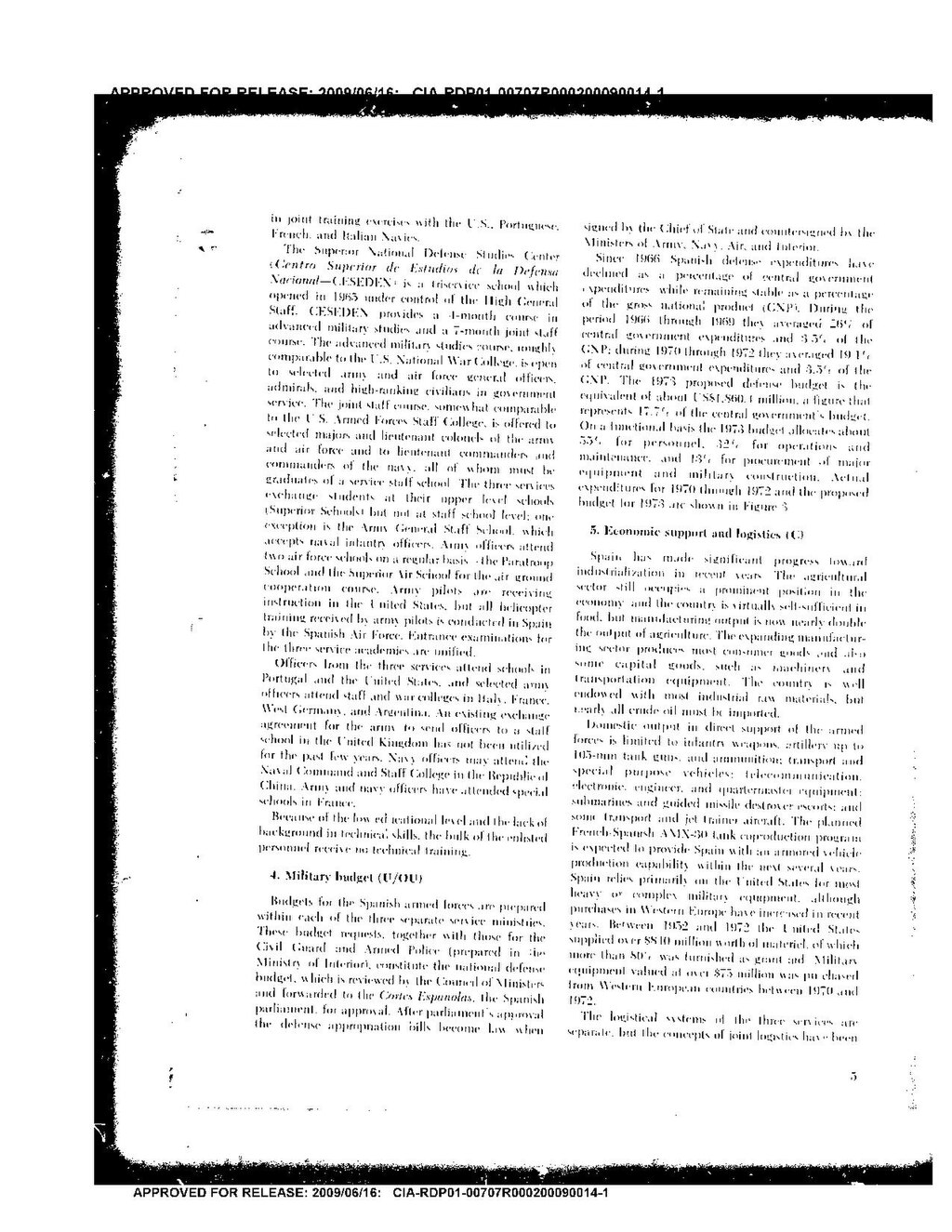APPROVED FOR RELEASE: 2009/06/16: CIA-RDP01-00707R000200090014-1
in joint training exercises with the US, Portuguese, French, and Italian Navies.
The Superior National Defense Studies Center (Centro Superior de Estudios de la Defensa Nacional - CESEDEN) is a tri-service school which opened in 1965 under control of the High General Staff. CESEDEN provides a 4-month course in advanced military studies and a 7-month joint staff course. The advanced military studies course, roughly comparable to the US National War College is open to selected army and air force general officers, admirals, and high-ranking civilians in government service. The joint staff course, somewhat comparable to the US Armed Forces Staff College, is offered to selected majors and lieutenant colonels of the army and air force and to lieutenant commanders and commanders of the navy, all of whom must be graduates of a service staff school. The three services exchange students at their upper level schools (Superior Schools) but not at staff school level; one exception is the Army General Staff School, which accepts naval infantry officers. Army officers attend two air force schools on a regular basis - the Paratroop School and the Superior Air School for the air ground cooperation course. Army pilots are receiving instruction in the United States, but all helicopter training received by army pilots is conducted in Spain by the Spanish Air Force. Entrance examinations for the three service academies are unified.
Officers from the three services attend schools in Portugal and the United States, and selected army officers attend staff and war colleges in Italy, France, West Germany, and Argentina. An existing exchange agreement for the army to send officers to a staff school in the United Kingdom has not been utilized for the past few years. Navy officers may attend the Naval Command and Staff College in the Republic of China. Army and navy officers have attended special schools in France.
Because of the low educational level and the lack of background in technical skills, the bulk of the enlisted personnel receive no technical training.
4. Military budget (U/OU)
Budgets for the Spanish armed forces are prepared within each of the three separate service ministries. These budget requests, together with those for the Civil Guard and Armed Police (prepared in the Ministry of Interior), constitute the national defense budget, which is reviewed by the Council of Ministers and forwarded to the Cortes Espanolas, the Spanish parliament, for approval. After parliament's approval the defense appropriation bills become law when signed by the Chief of State and countersigned by the Ministers of Army, Navy, Air, and Interior.
Since 1966 Spanish defense expenditures have declined as a percentage of central government expenditures, while remaining stable as a percentage of the gross national product (GNP). During the period 1966 through 1969 they averaged 26% of central government expenditures and 3.5% of the GNP; during 1970 through 1972 they averaged 19.1% of central government expenditures and 3.5% of the GNP. The 1973 proposed defense budget is the equivalent of about US $1,860.4 million, a figure that represents 17.7% of the central government's budget. On a functional basis the 1973 budget allocates about 55% of personnel, 32% for operations and maintenance, and 13% for procurement of major equipment and military construction. Actual expenditures for 1970 through 1972 and the proposed budget for 1973 are shown in Figure 3.
5. Economic support and logistics (S)
Spain has made significant progress toward industrialization in recent years. The agricultural sector still occupies a prominent position in the economy, and the country is virtually self-sufficient in food, but manufacturing output is now nearly double the output of agriculture. The expanding manufacturing sector produces most consumer goods and also some capital goods, such as machinery and transportation equipment. The country is well endowed with most industrial raw materials, but nearly all crude oil must be imported.
Domestic output in direct support of the armed forces is limited to infantry weapons, artillery up to 105-mm tank guns, and ammunition; transport and special purpose vehicles; telecommunication, electronic, engineer, and quartermaster equipment; submarines and guided missile destroyer escorts; and some transport and jet trainer aircraft. The planned French-Spanish AMX-30 tank co-production program is expected to provide Spain with an armored vehicle production capability within the next several years. Spain relies primarily on the United States for most heavy or complex military equipment, although purchases in Western Europe have increased in recent years. Between 1952 and 1972 the United States supplied over $840 million worth of materiel, of which more than 80% was furnished as grant aid. Military equipment valued at over $75 million was purchased from Western European countries between 1970 and 1972.
The logistical systems of the three services are separate, but the concepts of joint logistics have been
5
APPROVED FOR RELEASE: 2009/06/16: CIA-RDP01-00707R000200090014-1
